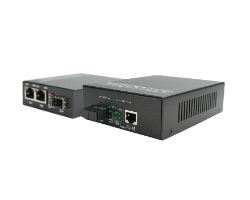A fiber media converter is a device that allows you to connect two different types of fiber optic cables. This can be useful if you need to connect two different devices that use different types of fiber optic cabling. If you’re in the market for a fiber media converter, there are a few things you should know before making your purchase. In this blog post, we will explore 5 things you need to know about fiber media converters. From compatibility to cost, we will cover everything you need to know before making your purchase.
What is a fiber media converter?
A fiber media converter is a device that allows different types of fiber optic cable to be connected together. It is used to connect two pieces of equipment that use different types of fiber optic cable, or to extend the distance between two devices that use the same type of cable. Fiber media converters can also be used to connect fiber optic cable to other types of cabling, such as copper Ethernet cables.
What are the benefits of using a fiber media converter?
Fiber media converters offer many benefits including:
1. Increased bandwidth – Fiber ethernet media converter can provide greater bandwidth than traditional copper media converters, allowing for higher data transfer rates.
2. Improved signal quality – Fiber optic signals are less susceptible to interference than copper signals, resulting in improved signal quality.
3. Greater distance support – Fiber optic cable can transmit signals over much longer distances than copper cable, making fiber media converters ideal for long-distance applications.
4. Reduced cabling costs – In many cases, fiber optic cable is less expensive than copper cable, making fiber media converters a more cost-effective solution.
What are the different types of fiber media converters?
Fiber media converters are devices that allow different types of fiber optic cable to be connected together. There are many different types of fiber media converters, each designed for a specific type of connection. The most common types of fiber media converters are:
-SC/ST Fiber Media Converter: This type of converter is used to connect an SC port to an ST port. It is the most common type of converter used in Ethernet networks.
-LC/ST Fiber Media Converter: This type of converter is used to connect an LC port to an ST port. LC ports are commonly used in fiber optic networks because they offer a higher data transfer rate than SC ports.
-FC/ST Fiber Media Converter: This type of converter is used to connect an FC port to an ST port. FC ports are typically used in high-speed fiber optic networks.
-MTRJ/ST Fiber Media Converter: This type of converter is used to connect an MTRJ port to an ST port. MTRJ ports are commonly used in Ethernet networks because they offer a higher data transfer rate than RJ45 ports.
How to choose the right fiber media converter for your needs
As the world increasingly moves towards a digital landscape, it’s important to have a clear understanding of the various technologies involved. One such technology is fiber media converters, which are devices used to connect two dissimilar media types, such as twisted pair and optical fiber.
There are a few things to keep in mind when choosing the right fiber media converter for your needs. First, you’ll need to consider the type of conversion you need – there are converters for single-mode or multimode applications, as well as those that support WDM (wavelength division multiplexing).
Next, you’ll need to think about the data rate and distance requirements of your application. Data rate is typically measured in Mbps (megabits per second), and distance is generally stated in kilometers (km).
Finally, you’ll want to take into account any additional features that may be important to you, such as support for Ethernet protocols or SFP (small form-factor pluggable) transceivers.
With all of these factors in mind, you should be able to find the right fiber media converter for your needs.
Conclusion
Fiber media converters are a vital part of any fiber optic network. Without them, data signals would not be able to travel between different types of networks. If you’re planning on setting up a fiber optic network, make sure you understand everything there is to know about fiber media converters before getting started. With the right knowledge, you’ll be able to set up your network quickly and easily.




